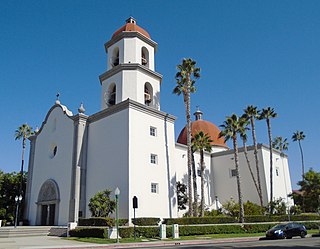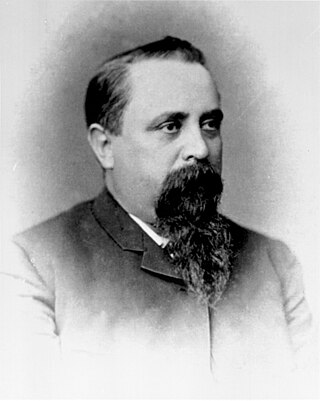
Mission San Juan Capistrano is a Spanish mission in San Juan Capistrano, Orange County, California. Founded November 1, 1776 in colonial Las Californias by Spanish Catholic missionaries of the Franciscan Order, it was named for Saint John of Capistrano. The Spanish Colonial Baroque style church was located in the Alta California province of the Viceroyalty of New Spain. The Mission was founded less than 60 yards from the village of Acjacheme. The Mission was secularized by the Mexican government in 1833, and returned to the Roman Catholic Church by the United States government in 1865. The Mission was damaged over the years by a number of natural disasters, but restoration and renovation efforts date from around 1910. It functions today as a museum.

San Juan Capistrano is a city in Orange County, California, located along the Orange Coast. The population was 34,593 at the 2010 census.

Saint Joseph's Day, also called the Feast of Saint Joseph or the Solemnity of Saint Joseph, is in Western Christianity the principal feast day of Saint Joseph, husband of the Virgin Mary and legal father of Jesus Christ, celebrated on 19 March. It has the rank of a solemnity in the Catholic Church. It is a feast or commemoration in the provinces of the Anglican Communion, and a feast or festival in the Lutheran Church. Saint Joseph's Day is the Patronal Feast day for Poland as well as for Canada, persons named Joseph, Josephine, etc., for religious institutes, schools and parishes bearing his name, and for carpenters. It is also Father's Day in some Catholic countries, mainly Spain, Portugal, and Italy. It is not a holy day of obligation for Catholics in the United States.

The cliff swallow or American cliff swallow is a member of the passerine bird family Hirundinidae, the swallows and martins. The generic name Petrochelidon is derived from Ancient Greek petros meaning "rock" and khelidon "swallow", and the specific name pyrrhonota comes from purrhos meaning "flame-coloured" and -notos "-backed".

John of Capistrano was a Franciscan friar and Catholic priest from the Italian town of Capestrano, Abruzzo. Famous as a preacher, theologian, and inquisitor, he earned himself the nickname "the Soldier Saint" when in 1456 at age 70 he led a crusade against the invading Ottoman Empire at the siege of Belgrade with the Hungarian military commander John Hunyadi.

Mission Basilica San Juan Capistrano is a Catholic parish in the Diocese of Orange in California. The parish church is located just northwest of Mission San Juan Capistrano in the city of San Juan Capistrano, California, United States. Completed in 1986, it was designated a minor basilica in 2000 and a national shrine in 2003.

The Las Flores Estancia was established in 1823 as an estancia ("station"). It was part of the Spanish missions, asistencias, and estancias system in Las Californias—Alta California. Las Flores Estancia was situated approximately halfway between Mission San Luis Rey de Francia and Mission San Juan Capistrano. It is located near Bell Canyon on the Camp Pendleton Marine Corps Base ten miles south of the City of San Clemente in northern San Diego County, California. The estancia is also home to the architecturally significant National Historic Landmark Las Flores Adobe, completed in 1868.

Mission San Juan Capistrano was founded in 1731 by Spanish Catholics of the Franciscan Order, on the eastern banks of the San Antonio River in present-day San Antonio, Texas. The new settlement was named for a 15th-century theologian and warrior priest who resided in the Abruzzo region of Italy. The mission San Juan was named after Saint John of Capestrano.

Rancho de los Palos Verdes was a 31,629-acre (128.00 km2) Mexican land grant in present-day Los Angeles County, California given in 1846 by Governor Pío Pico to José Loreto and Juan Capistrano Sepulveda. The name means "range of green trees". The grant encompassed the present-day cities of the Palos Verdes Peninsula, as well as portions of San Pedro and Torrance.

The Acjachemen are an Indigenous people of California. They historically lived south of what is known as Aliso Creek and north of the Las Pulgas Canyon in what are now the southern areas of Orange County and the northwestern areas of San Diego County.

The Diego Sepúlveda Adobe is an adobe structure in Costa Mesa, Orange County, California.
Leon René was an American music composer of pop, R&B and rock and roll songs and a record producer in the 1930s, 1940s, and 1950s. He sometimes used the songwriting pseudonym Jimmy Thomas or Jimmie Thomas. He also established several record labels.
Rancho Boca de la Playa was a 6,607-acre (26.74 km2) Mexican land grant in present-day Orange County, California given in 1846 by Governor Pío Pico to Emigdio Véjar. The name refers to the wetlands estuary at the 'mouth of the beach,' or 'boca de la playa' in Spanish. This is the most southerly grant in Orange County, and extended along the Pacific coast from San Juan Creek in the south of present-day San Juan Capistrano south to San Clemente.
"When the Swallows Come Back to Capistrano" is a song written by Leon René and first recorded by The Ink Spots featuring Bill Kenny in May 1940. The Ink Spots' recording of the song reached No. 4 on the US charts.

The Los Rios Historic District is an historic district and neighborhood in the city of San Juan Capistrano, California. With buildings dating to 1794, it is the oldest continually occupied neighborhood in the state. The nearby Mission San Juan Capistrano was the first of the 21 California Missions to have Indians, soldiers and workers live outside the mission grounds. Three adobes remains in the Los Rios neighborhood itself, although there are a number of others close by which were part of what was once a larger neighborhood.

The Mexican Secularization Act of 1833, officially called the Decree for the Secularization of the Missions of California, was an act passed by the Congress of the Union of the First Mexican Republic which secularized the Californian missions. The act nationalized the missions, transferring their ownership from the Franciscan Order of the Catholic Church to the Mexican authorities.

Jose Dolores Sepulveda Adobe is an adobe home built in 1818. It is located at the Rancho de los Palos Verdes in Torrance, California. The Jose Dolores Sepulveda Adobe was designated a California Historic Landmark on Jan. 03, 1944. The Jose Dolores Sepulveda Adobe was built by José Dolores Sepúlveda, his son was Mayor of Los Angeles from 1837 to 1848. José Dolores Sepúlveda’s father was José Loreto Sepúlveda (1764–1808). The location is now a private residence in Torrance. The original Adobe is gone, but the current homeowner renovated the house to reflect the Rancho history. Rancho de los Palos Verdes means "range of green trees". The Rancho is now the present-day cities of the Palos Verdes Peninsula, as well as portions of San Pedro and Torrance.

The Sepúlveda family is a prominent Californio family of Southern California. Members of the family held extensive rancho grants and numerous important positions, including Alcalde de Los Ángeles, California State Assemblymen, and Los Angeles County Supervisor.

Alume was a large Acjachemen village located between Trabuco Creek and Tijeras Creek at Rancho Santa Margarita, California. The village was also recorded as Alaugna and as El Trabuco in San Juan Capistrano mission records, and is also referred to as Alauna, Aluna, and Alona.















